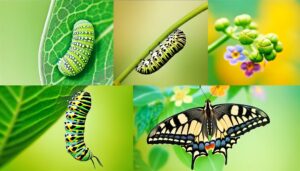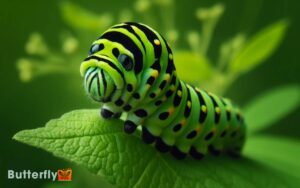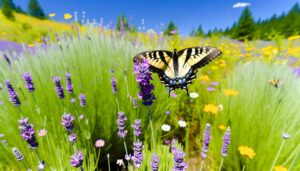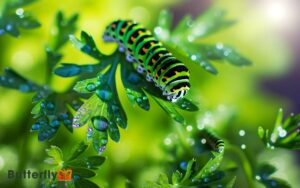Citrus Swallowtail Butterfly Life Cycle: Explore Stages!
The Citrus Swallowtail butterfly begins life as a spherical, pale yellow egg laid on young citrus leaves. After 6-10 days, the larva hatches and starts feeding voraciously on citrus foliage, undergoing multiple molts.
Initially camouflaged as bird droppings, the caterpillar’s appearance later mimics small snakes for protection. Following the larval stage, the chrysalis forms, facilitating the metamorphosis into an adult butterfly.
The adult emerges, expands its wings, hardens them, and then seeks nectar and mates. Such intricate stages highlight the complexity and adaptability of this species’ life cycle. Understanding each phase offers deeper insights into its survival strategies.
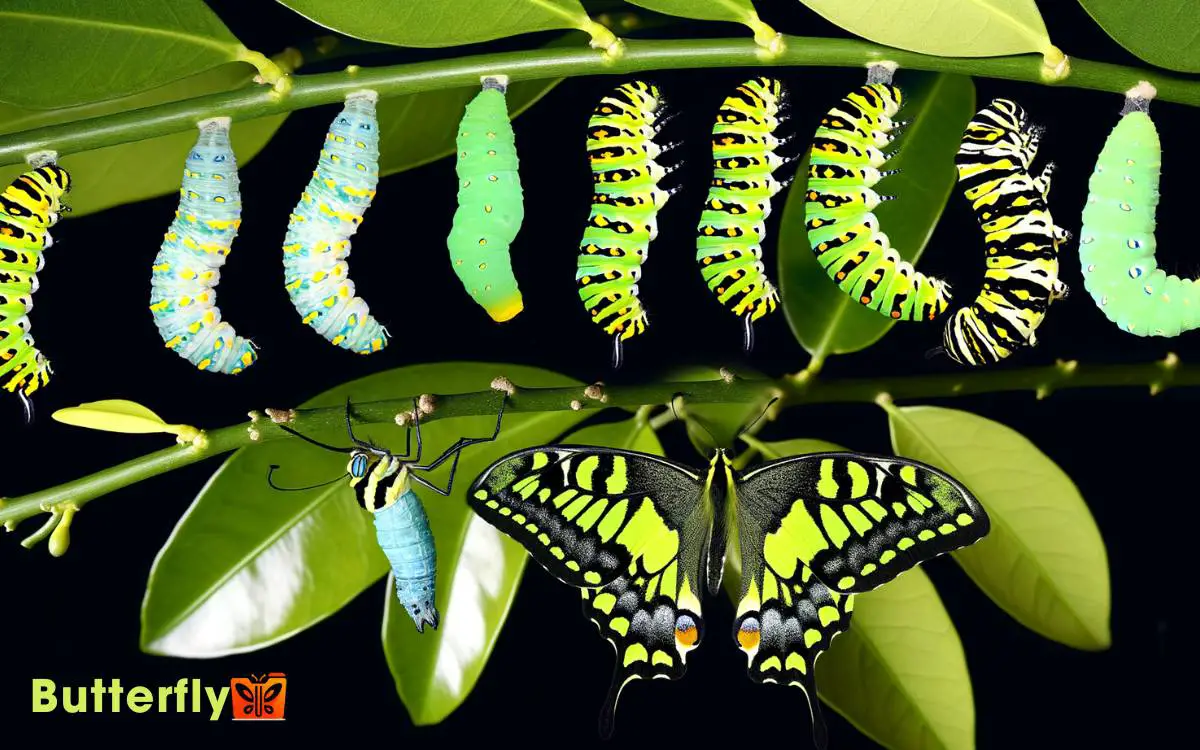
Key Takeaways
Egg Laying
The female Citrus Swallowtail butterfly meticulously deposits her eggs on the underside of young citrus leaves, ensuring ideal conditions for the larvae. This strategic placement offers protection from predators and harsh environmental conditions. As the eggs hatch, the larvae emerge and begin feeding on the tender foliage, gaining essential nutrients for growth. This close relationship between swallowtail butterflies and citrus trees highlights the importance of host plants in the butterfly’s life cycle. Over time, the caterpillars undergo several molts before forming chrysalises, eventually transforming into striking adult butterflies.
She’ll use her finely-tuned sensory organs to select leaves with excellent nutritional content.
Each egg, spherical and pale yellow, adheres firmly to the leaf surface through a sticky secretion. These eggs are typically laid individually, reducing competition among emerging larvae.
The butterfly’s precision in egg placement is essential for the survival of her offspring. By choosing the underside of the leaves, she maximizes the chances of successful hatching and subsequent larval development.
This careful selection process exemplifies the butterfly’s innate drive to perpetuate her species.
Egg Development
During egg development, the Citrus Swallowtail exhibits specific egg-laying behavior, often selecting the underside of citrus leaves for best protection.
The incubation period typically lasts 6-10 days, influenced by temperature and humidity.
Environmental factors such as light exposure and leaf surface conditions also greatly affect embryonic development.
Egg Laying Behavior
Female Citrus Swallowtails strategically select young, tender leaves to deposit their eggs, ensuring ideal conditions for larval development. They exhibit a preference for citrus plants, leveraging their olfactory receptors to locate suitable foliage.
Each egg is carefully positioned to maximize sunlight exposure and minimize predation risk, reflecting an evolved reproductive strategy.
The eggs, spherical and pale yellow, are laid singly, reducing competition among emerging larvae. This placement aids in camouflaging the eggs against potential threats.
Female swallowtails demonstrate meticulous behavior, often inspecting multiple leaves before making a final decision. Their egg-laying process is influenced by environmental factors, including temperature and humidity, which can affect egg viability.
Through these precise actions, they enhance the survival rate of their offspring.
Incubation Period Insights
Egg development in the Citrus Swallowtail butterfly undergoes a meticulous incubation period influenced by specific environmental conditions. Typically, the eggs hatch within 6 to 10 days, but this duration can vary based on temperature and humidity.
Each egg undergoes cellular differentiation, forming an embryonic caterpillar. The eggshell, or chorion, provides protection while allowing gas exchange critical for embryonic respiration.
Through detailed observation, researchers note that higher temperatures tend to accelerate development, while cooler conditions prolong it.
The initial stages involve segmentation and organ formation, visible under magnification. This precise period culminates when the larva emerges, driven by enzymatic processes that weaken the chorion.
Understanding these insights offers a glimpse into the intricate early life stages of this remarkable butterfly.
Environmental Impact Factors
Environmental parameters like temperature, humidity, and photoperiod greatly influence the developmental rate and success of Citrus Swallowtail butterfly eggs.
Temperature directly impacts the metabolic rate, accelerating or decelerating embryonic growth. Ideal humidity levels prevent desiccation, ensuring egg viability.
Photoperiod conditions regulate hormonal cycles that synchronize development with environmental cues, promoting successful hatching.
Here’s a comparative overview:
| Parameter | Ideal Range | Impact on Egg Development |
|---|---|---|
| Temperature | 25-30°C | Faster development, higher survival |
| Humidity | 60-80% | Prevents desiccation, boosts viability |
| Photoperiod | 14 hours light, 10 hours dark | Synchronizes hormonal cycles |
Understanding these factors allows for effective conservation strategies, ensuring the freedom of this species to thrive in its natural habitat.
Larval Stage
During the larval stage, the Citrus Swallowtail caterpillar displays specific feeding and growth patterns that promote rapid development.
The caterpillar utilizes effective camouflage and protective mechanisms to evade predators.
As it grows, it undergoes multiple molting phases, each marking a distinct stage in its development.
Feeding and Growth Patterns
As the larval stage commences, the Citrus Swallowtail caterpillar exhibits voracious feeding behavior, primarily consuming the leaves of citrus plants to fuel its rapid growth.
The caterpillar’s diet consists exclusively of citrus foliage, enabling it to accumulate essential nutrients. Feeding continuously, it undergoes several molts, each time shedding its exoskeleton to accommodate its increasing size.
The table below illustrates the growth stages and corresponding feeding patterns:
| Larval Instar | Feeding Duration (Days) | Growth Rate (mm/day) |
|---|---|---|
| First Instar | 2-3 | 1.0 |
| Second Instar | 3-4 | 1.5 |
| Third Instar | 4-5 | 2.0 |
This feeding strategy guarantees the caterpillar achieves the necessary mass and energy reserves for its impending metamorphosis.
Camouflage and Protection
While the Citrus Swallowtail caterpillar voraciously feeds to fuel its growth, it simultaneously employs remarkable camouflage techniques to evade predators.
Initially, the young larvae resemble bird droppings, a disguise that deters potential threats. This cryptic coloration allows them to blend seamlessly with their surroundings, making them less conspicuous.
As they mature, their appearance changes to mimic small snakes, a strategy to intimidate predators. The caterpillar’s body features intricate patterns and colors that enhance this mimicry, further ensuring its survival.
Additionally, the larvae possess an osmeterium, a specialized organ that emits a foul-smelling chemical when threatened. This defense mechanism effectively repels predators, providing an additional layer of protection.
Through these adaptations, the Citrus Swallowtail caterpillar navigates its perilous environment with remarkable efficacy.
Molting and Development Stages
The Citrus Swallowtail caterpillar undergoes several instars, or molting stages, each marked by shedding its exoskeleton to accommodate rapid growth.
In its first instar, the caterpillar is tiny and black with a white saddle marking, camouflaging as bird droppings. As it progresses into the second and third instars, it retains this appearance while increasing in size.
By the fourth instar, the caterpillar shifts to a vivid green color with white and black markings, blending seamlessly with citrus leaves. Each molt is vital, allowing the larva’s size and internal organs to expand.
These precise stages guarantee the caterpillar reaches ideal size and readiness for the pupal stage, where it will undergo metamorphosis into the adult butterfly.
Caterpillar Feeding
Caterpillars of the Citrus Swallowtail butterfly frequently feed on the tender leaves of citrus plants, rapidly consuming large amounts of foliage.
Their mandibles efficiently slice through the leaf tissue, maximizing nutrient intake. These larvae exhibit a preference for young, succulent leaves, which provide essential nutrients for their growth.
The feeding behavior is vital; they can strip a plant of its leaves within days. As they feed, caterpillars excrete frass, which can be observed accumulating around the feeding site.
This pivotal feeding phase is important for energy accumulation required for subsequent developmental stages.
The caterpillars’ green coloration and mimicry of bird droppings offer effective camouflage against predators, facilitating uninterrupted feeding. Their impact on citrus plants can be significant, necessitating careful management in orchards.
Molting Phases
After accumulating the necessary energy through voracious feeding, these larvae undergo a series of molting phases that facilitate their continued growth and development. Molting, or ecdysis, involves shedding the old exoskeleton to accommodate their increased size.
Each larval stage between molts is called an instar. Observing these phases reveals fascinating details about their adaptability and resilience.
- First Instar: Tiny larvae with a black body and white saddle.
- Second Instar: Slightly larger, with more distinct coloration patterns.
- Third Instar: Noticeable growth, with green and brown camouflage.
- Fourth Instar: Significant size increase, exhibiting vivid color changes.
- Final Instar: Prepares for pupation, displaying mature coloration and intricate patterns.
These stages ensure optimal development towards the next transformative phase.
Pupal Stage
Upon reaching the final instar, the larvae undergo a significant transformation by forming a pupal case, known as a chrysalis. This stage is vital for the Citrus Swallowtail Butterfly, as it facilitates the metamorphosis from larva to adult.
The chrysalis, typically green or brown, provides camouflage against predators. Inside, the larva’s body structure breaks down and reorganizes, forming the adult butterfly’s features.
This process, known as histolysis and histogenesis, involves the dissolution of larval tissues and the development of adult tissues.
The pupal stage can last from several days to weeks, depending on environmental conditions such as temperature and humidity. During this time, the chrysalis remains motionless, ensuring the delicate transformations occur undisturbed.
Emergence
As the pupal stage concludes, the mature Citrus Swallowtail Butterfly initiates its emergence from the chrysalis, revealing its fully developed wings and intricate patterns. The process, known as eclosion, is meticulously timed to guarantee ideal survival conditions.
The butterfly uses rhythmic contractions to split the chrysalis and slowly extricate itself. Upon emergence, it pumps hemolymph into its wings to expand them fully, a process critical for flight readiness.
- Eclosion: The precise timing of emergence to coincide with favorable environmental conditions.
- Hemolymph circulation: Essential for wing expansion and subsequent hardening.
- Chrysalis splitting: Achieved through coordinated muscular contractions.
- Wing expansion: Involves the gradual release of hemolymph to stretch and form the wing structure.
- Initial vulnerability: The butterfly remains vulnerable until its wings harden and dry.
Adult Butterfly
The adult Citrus Swallowtail Butterfly, now fully developed with hardened wings, immediately begins its quest for nectar and mates.
It navigates through lush habitats, favoring sunny areas with abundant flowering plants. The butterfly’s proboscis, a specialized feeding organ, uncoils to access nectar deep within blossoms.
Males engage in territorial behavior, patrolling and defending prime locations to attract females. Courtship involves intricate flight patterns and pheromone signaling.
Females, after mating, seek out suitable citrus plants to lay their eggs, ensuring the next generation’s survival.
The adult stage, though essential, plays a vital role in the life cycle, driving both reproduction and pollination. Their vibrant wings and graceful flight embody the ultimate freedom of the lepidopteran world.
Conclusion
The citrus swallowtail butterfly’s life cycle, from egg to adult, symbolizes nature’s intricate dance of transformation. Each stage, from the delicate egg to the voracious caterpillar, represents a step in this metamorphic journey.
As the chrysalis holds the promise of change, the emergence of the butterfly signifies the culmination of life’s potential.
This cycle, marked by scientific precision and detailed observation, reminds us of the delicate balance and resilience inherent in the natural world.

